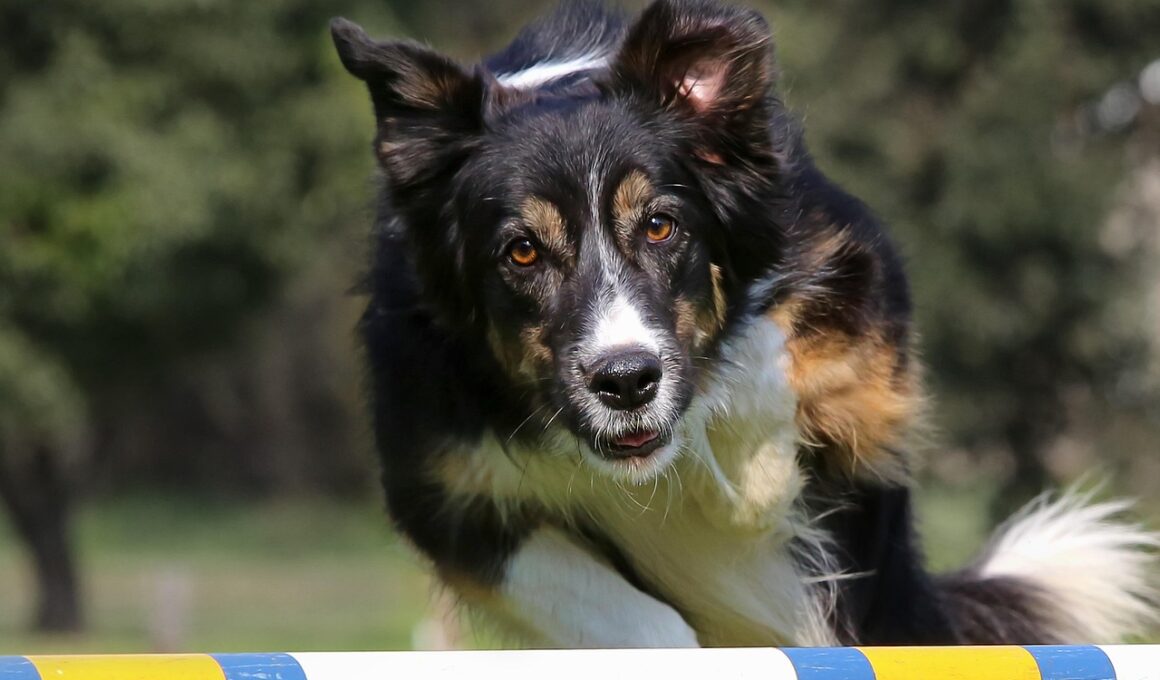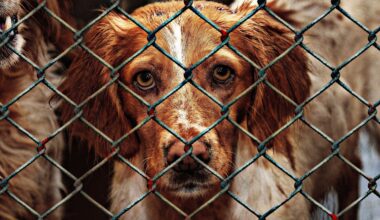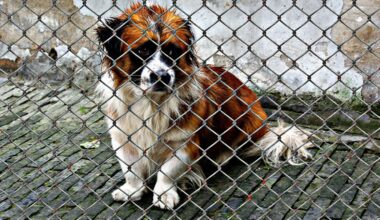Common Judging Criteria in Dog Shows Explained
Dog shows have fascinated dog lovers for years, presenting a platform where purebred dogs compete for accolades and recognition. The judging process is intricate, with several criteria that contribute to a dog’s overall score. The first criterion is breed standard, which entails assessing various traits outlined by kennel clubs. Judges meticulously evaluate factors such as coat, color, size, and general appearance. Furthermore, a dog’s behavior during the competition is critical, as judges look for confident, relaxed dogs that represent their breed well. Another significant element includes the dog’s structure, which influences movement and overall health. A dog should exhibit proper conformation, allowing it to move freely and gracefully. Judges also consider the dog’s temperament, as a friendly and approachable demeanor is essential. Performance in the ring is meticulously observed, as it reflects the dog’s training and handler’s skill. Additional criteria can involve grooming techniques and presentation, which play a vital role in how well the dog catches the judge’s eye. Ultimately, these combined factors dictate the success of a dog in a show, making it imperative for owners to prepare thoroughly.
Aside from the fundamental breed standards, judges assess how well the dog complies with the organization’s requirements and regulations. This involves evaluating the dog’s build, overall health, and attitude in comparison with others in its category. Each dog must fulfill health standards, which are crucial for displaying high standards of breeding practices. Judges often require examination of various aspects such as dental health and potential genetic issues. Health validations ensure that dogs competing are not only show-worthy but also vital for the longevity of their breed. Performance evaluation during routines is another aspect judges consider; dogs must show agility paired with obedience. Judges appreciate the ability of the handler to communicate effectively with their dog, demonstrating well-rehearsed teamwork. Social skills are assessed too, particularly how the dog interacts with the judge and during group showing. Winning is not only about having the ‘best’ dog on paper but also showcasing strong handler-dog partnerships. Other parts of the competition include specific events like agility trials, where different skills are judged beyond traditional conformation, allowing versatility for breeds to shine.
Evaluation of Movement in Dog Showing
Movement assessment is a crucial part of judging in dog shows, as it reveals many insights about the dog’s overall health and formation. Dogs are judged on their ability to move freely, exhibiting fluidity and balance, which are essential for any breed. Proper movement can indicate excellent structural integrity, where the general alignment of bones and muscles supports smooth performance. Judges will look closely at the gait pattern—whether it is even and rhythmic—offering insight into how well the dog is put together. High-stepping may indicate breeding for show but can also reflect excessive energy, while a relaxed gait may suggest calmness and confidence. Additionally, dogs with incorrect movements may indicate underlying issues, making this evaluation particularly important for breeders and trainers. The speed and efficiency of movement are also crucial; dogs should not only move well but should do so at a suitable speed. Show dogs are expected to exhibit specific movements such as the trot and canter, highlighting their athletic capabilities. All these aspects combined help determine a dog’s ranking in its category.
Along with movement evaluations, the type of leash and collar used plays a vital role in the show. Handlers typically choose colors and styles that enhance their dog’s appearance while ensuring ease of control. While leash types can vary, judges prefer those that don’t distract from the dog’s beauty or movements. Traditional leather leashes are often favored for their durability, while others might opt for styles like martingale collars or show leads—depending on breed and condition. The presentation technique employed by the handler also significantly influences the dog’s impression and score. Dog handling, showcasing the dog’s best features while protecting its comfort during the show, is an acquired skill. Each handler must balance timing, control, and visual appeal to make a positive impression on judges. Observing proper etiquette is likewise essential; treating the judge with respect can influence a dog’s scoring. Additionally, interaction with the audience matters as well. A confident and sociable dog can leave a lasting impression on followers, promoting breed positivity and acceptance.
Importance of Training and Preparation
Training and preparation are paramount for any dog entering a show. Regular practice allows dogs to become familiar with the routines they will encounter on the day of competition. From getting used to the judge’s examination to learning how to walk correctly on a leash, preparation fosters confidence and poise. Handlers often spend months, sometimes even years, training their dogs to perfect their skills and behaviors. Building a rapport between dog and handler helps cultivate this environment, where the dog feels secure and ready to perform. Routine socialization is also pivotal, as it prepares dogs for various stimuli that come with dog shows. Shows often involve bustling crowds, competing dogs, and loud noises, so desensitizing dogs to these elements can ensure a less stressful experience. Using positive reinforcement techniques promotes the desired behaviors, as dogs perform well when they feel appreciated and encouraged. Understanding the specific traits that may attract a judge’s eye can help trainers tailor their preparation focusing on areas of improvement needed for their dog’s success.
Furthermore, the relationship between the handler and the dog cannot be overlooked; it directly impacts performance levels during the show. A consistent training schedule, coupled with understanding a dog’s moods and behavioral cues, establishes a solid partnership. Handlers facilitate learning by using positive reinforcement methods rather than punitive measures, allowing for creativity to interpret the judging criteria while responding effectively to the dog’s needs. A training regimen that incorporates frequent, short sessions proves beneficial not only for the dog but also for handler fatigue. Regular practice helps keep energy levels high and ensures that the dog can focus during competitions. Mental stimulation is equally important, indicating to handlers that their dog is engaged and attentive. Overall, preparation entails more than just practicing movements; it’s a holistic approach encompassing grooming, building confidence, and nurturing the handler-dog bond while ensuring that both enjoy the journey towards potentially winning a prestigious title.
Grooming and Presentation Techniques
Grooming and presentation are essential elements judged in dog shows, contributing significantly to a dog’s overall impression. Proper grooming not only highlights a dog’s best features but also signifies the love and care invested in them by the owner. Each breed has specific grooming requirements that handlers must fulfill to align with show standards, from different coat types to specific trims. Judges will assess coat texture, cleanliness, and the level of preparedness exhibited by handlers. Presentation is equally important; handlers must demonstrate the ability to showcase a dog effectively while maintaining a level of comfort for the animal. The attitude exhibited during the show can influence a judge’s perception; dogs should appear relaxed and proud as they trot around the ring. Common practices include positioning within the ring, where handlers must learn how to stage their dog to accentuate its best qualities. A well-groomed dog with a confident presentation is likely to resonate positively with judges, showcasing the importance of grooming and effective delivery in the competitive environment of dog shows.
In conclusion, the criteria for judging dogs at shows are broad and multifaceted, covering everything from breed standards and structure to movement and handler interaction. Success at these events demands a fusion of preparation, training, and grooming, with each factor intricately connected to the outcome of the show. Owners must dedicate time and resources to ensure their dogs meet health standards, receive adequate training, and are groomed to perfection. Understanding these components allows participants to better navigate the competitive landscape of dog shows while aiming for top placements. Each aspect is linked to the dog’s performance level, which, in turn, reflects its innate characteristics and training prowess. The collaboration between handler and dog stands as a testament to their relationship and can significantly influence a judge’s scoring. Whether a dog finishes in first place or not, the experience garnered during competition contributes tremendously to the bond shared between dog and owner. Knowing how to present the entirety of their dog’s temperament, health, and training through competitions aims not only to win accolades but also educate the public about the beauty and versatility of canine companionship.


